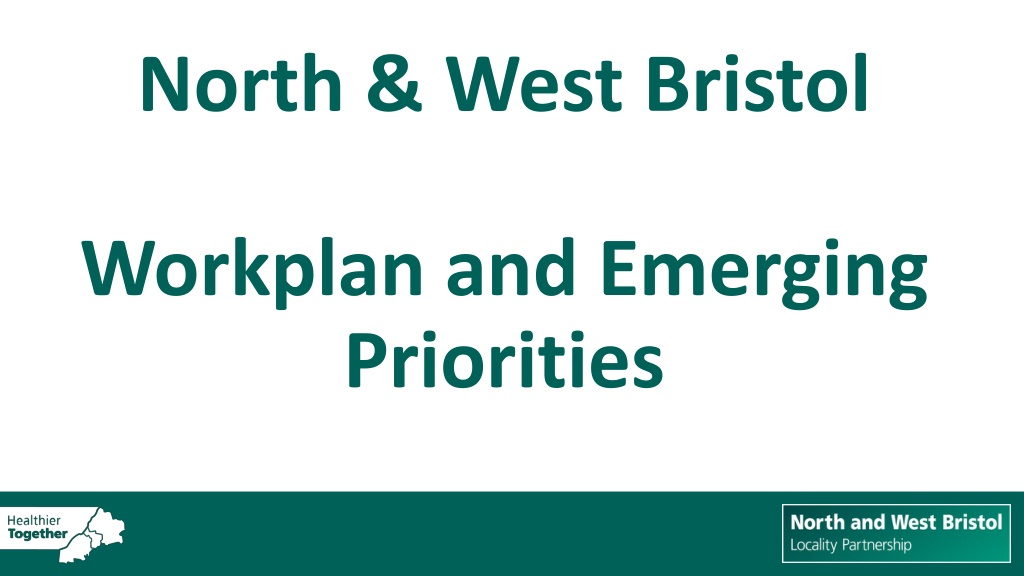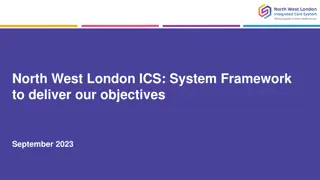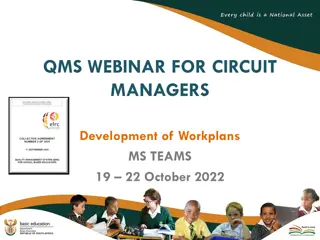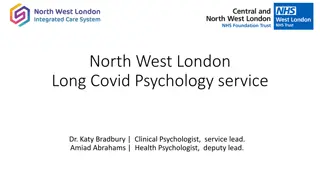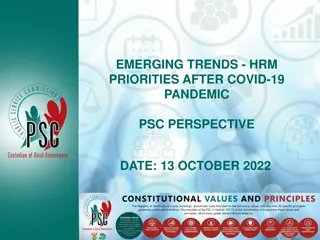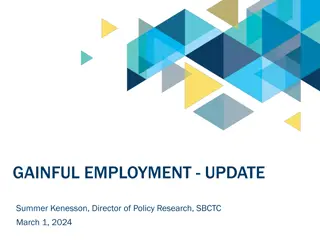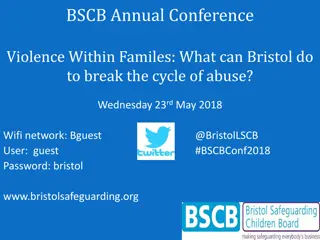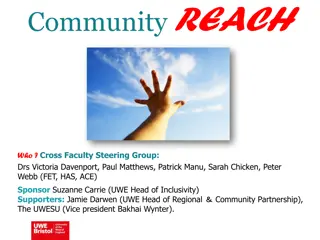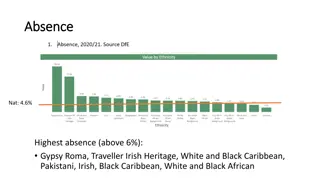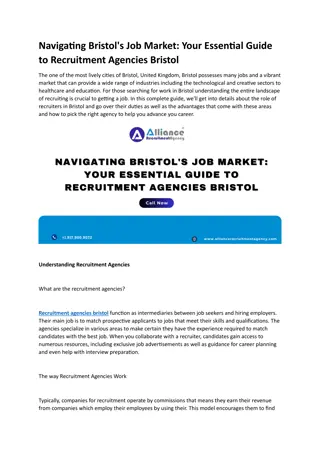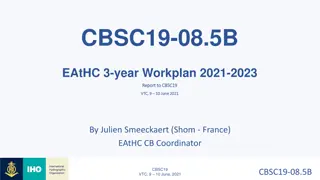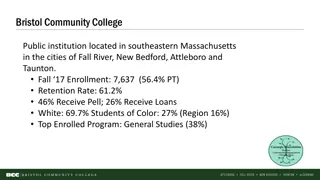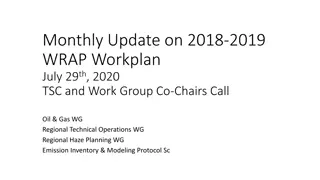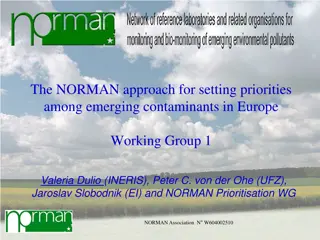North & West Bristol Workplan and Emerging Priorities
Our vision for North and West Bristol is to empower individuals to live their best lives by focusing on strengths, reducing inequalities, and providing personalized care. Priority areas include mental health, substance misuse, aging well, healthy weight, and children's mental health.
Download Presentation

Please find below an Image/Link to download the presentation.
The content on the website is provided AS IS for your information and personal use only. It may not be sold, licensed, or shared on other websites without obtaining consent from the author.If you encounter any issues during the download, it is possible that the publisher has removed the file from their server.
You are allowed to download the files provided on this website for personal or commercial use, subject to the condition that they are used lawfully. All files are the property of their respective owners.
The content on the website is provided AS IS for your information and personal use only. It may not be sold, licensed, or shared on other websites without obtaining consent from the author.
E N D
Presentation Transcript
North & West Bristol Workplan and Emerging Priorities
Our Vision: We want people in North and West Bristol to live the best lives they possibly can. We will start with people s strengths and a conversation about what good life looks like to them, rather than simply focusing on their problems. We want people to be part of their communities, helped where we need it to connect to people and things that give our lives meaning and purpose - relationships, friends, family, work, leisure and to share their gifts and talents. We will strive to reduce all inequalities in North and West Bristol. We will reduce the gap between those with the worst health and best health and care experiences and outcomes. We will do this by directing focus and our resource towards areas of greater inequality. People should feel listened to and only have to tell their story once. For those who need more intensive support, they will be able to contact a very trusted person who knows them and who helps coordinate their care. We want people to have control and influence over what health and care they receive, where and when they receive it. The desire to support people to live independently for as long as possible and prevent people s situation worsening, drives how we work. In North and West Bristol people will be supported to live in their own homes, with the necessary adaptions, technology, clinical input and flexible personal support directed by them. People should be trusted to make decisions and direct their own support, with help where they need and want it, with barriers, such as difficult forms, to accessing care minimised. People also know where to goa when they need additional support and have access to good information and someone they can talk to. We will try to learn about what works for people and work collaboratively and pool our resources to develop these approaches to health and care for everyone in the Place. We will reduce boundaries between organisations by working in an integrated way with Partners across the health, care and the voluntary and community sector. Clinicians and practitioners, properly rewarded, will be given the chance to use their creativity, skills and judgement in proper partnership with people. Empowering people and their communities, and their voices, to improve their health and wellbeing
North & West Bristol Priorities Now implementing our Community Mental Health Integrated & Personalised Care Team (IPCT) Understanding the impact alcohol and substance misuse has on mental and physical health There are high rates of attendance at ED for deliberate self-harm in the 10-24 year olds Anticipating health and care needs in our Ageing Well population Enhanced Health in Care Homes: avoiding unnecessary escalation of care Working with communities to explore whether co-designed community interventions can reduce use of unplanned care before people get sick or frail Working to reduce prevalence of unhealthy weight for children in year 6 in our outer wards Working to slow the increase in anxiety and poorer mental health in children
Delivery Phase Planning Phase Discovery Phase Anticipating health and care needs in our Ageing Well population Prevalence of unhealthy weight for children in year 6 in our outer wards is amongst the highest in BNSSG Now implementing our Community Mental Health Integrated & Personalised Care Team People who live in our outer wards use a disproportionate amount of unplanned care to manage their COPD There are high rates of deliberate self-harm in 10-24 year olds Recovery Navigators (Commence Jan 23) Thrive Training (operational) There is a rise in anxiety and poorer mental health in children Peer Support (in discussion) Wellbeing College (operational) Enhanced Health in Care Homes: avoiding unnecessary escalation of care by enabling good conversations between care home staff, GPs, medics and paramedics Prevalence of diabetes in our outer wards is amongst the highest in BNSSG Working with communities to explore whether co-designed community interventions can reduce use of unplanned care before people get sick or frail Build empathy for ageing by workforce training Develop a Multi- Disciplinary Team approach Understanding the impact alcohol and substance misuse has on mental and physical health Embed system- wide Falls Programme Community Wellbeing Board Delivery Board Data Insight Use digital solutions to maximise care home staff and GP time Leadership Board Evidence 2022-2025
What we know: In response to the new Community Mental Health Framework, the North & West Bristol locality (N&W) produced a Target Operating Model detailing how it would bring primary care, secondary care and the voluntary and community sector together to form an Integrated and Personalised Care Team (IPCT). The N&W IPCT has been developed to provide wrap-around care & support to people with a mental health need. The IPCT aims to work with people to address poor physical and mental health - and more broadly - social care needs, access to public funds, education, employment and more constructive interactions with the wider system such as criminal justice. Community Mental Health - Integrated & Personalised Care Team (IPCT) Goal: The IPCT will support the person to co-produce a plan that, with the support of their Care Coordinator, will help them to smoothly navigate and address the gap between primary and secondary care systems and access the support they need. Approach: The N&W CMH Target Operating Model represents the delivery of a psycho-social model connecting VCFSE, primary and secondary care provision and social care encompassing the following interventions: We will facilitate access to Virtual Group Consultation (now Health and Wellbeing Groups) We will develop a tailored local Wellbeing College prospectus to help with better self management We will ensure Recovery Navigation resource is available to help coordinate and facilitate access to the right level of services We will ensure there is access to Peer Support when needed We will develop improved joint working and links to specialist mental health service pathways We will facilitate improved links to hyper-local voluntary and community support through the IPCT service The N&W IPCT is working with the Mental Health VCSE Alliance to deliver the above
What we know: Bristol suicide rates are higher than the national average, and the Southwest has the highest suicide rates of any English region. It has been estimated that about 50% of people who died of suicide have previously self- harmed In 2020/21 in Bristol there were 1,717 emergency admissions to hospital due to intentional self-harm (the rate of 332.4 per 100,000 population, significantly higher than England average of 184 per 100,000). The data shows that 68% of those admissions for self harm were among females, and this highlights the fact that the rates of intentional self-harm were almost 2 times higher among women than men . Self-poisoning was the most frequently used method of self-harm (66.4%) About 8.8% of people used both self-injury and self-poisoning . Emergency hospital admissions as a result of self-harm in children and young people aged 10-24, rate per 10,000 in NW Bristol (605.1) was significantly higher than England (421.9) Deliberate Self Harm Goal: Reduction in self harm admissions for N&W population by identifying and targeting specific areas with the relevant self harm reductions interventions. Approach: We will analyse data and intelligence to provide a more accurate and richer N&W picture to highlight key target areas where more intensive support can be mobilised We will analyse data to understand the link between drug and alcohol misuse, as well as pain We will map existing interventions local and national to help understand the level of help and support already available and sign post provide this information, advice and support to those that need it. We will pull together a Working group with all the key stakeholders to design and develop better coordination between the N&W IPCT and the local and national interventions to help reduce the level of admissions in the North and West. Connect in to Children and Families workstream to ensure interdependencies are identified and considered
CMH Other areas of focus SMI Physical Health Checks Older Persons Mental Health Learning Disabilities & Autism Suicide and Self Harm Demand identification for Older Persons MH Service Mapping - commissioned statutory and Vol orgs IAPT & older People Dementia Services demand audit Older Persons Social Care Offer Social care audit older people in care homes Development of LD case studies to identify types of need Audit of community LD rejections 4 weeks in Nov to identify potential demand GP data collection and review to flag up numbers Workforce challenges from CLD to flag up gaps in service provision Mapping of existing services and support Analysis of data and intelligence to provide N&W picture Mapping existing interventions local and national Working group to develop IPCT related offer Data consolidation between AWP & GP Practice systems Development of data entry standard template for Emis Identify and agree on the definition of SMI for practices Work with AWP to develop a digital solutions to SMI Physical Health Checks Projects
What we know: Within North & West Bristol, there is a significant difference in life expectancy between the most deprived and the most affluent areas. Outer wards in North & West Bristol have significantly lower male and female life expectancy at birth compared to England, and people living in these wards are more likely to die younger from cancer, respiratory illness, heart disease and stroke Goal: Our vision is to seek to make North & West Bristol a good place to grow old. We will play our part in adopting the Age-friendly Bristol Action Plan which: Identifies ways to make Bristol a more liveable and enjoyable place for people to grow older, ensuring age it not a barrier to staying independent and active in city life. We work with older people and partners across the public, private, and voluntary and community sectors to do this . As a Locality Partnership, we will work together to maximise the opportunities for people as they grow older preparing them for the later stages of life, maintaining their quality of life, making it possible for them to remain in their own homes and live an independent life safely. As people grow older, we want them to have access to person centred services when required. Our vision is to have an integrated workforce across all relevant agencies, with access to high quality training. Development of services and interventions will be data driven, evidence based and co-designed with people with lived experience as well VCFSE organisations and health and care workforce within North & West Bristol. Ageing Well Tackling this health inequality is one of our major challenges and we re committed to working with our citizens to support them to make healthy choices. Approach: The emphasis will be: Safe delivery of the Enhanced Health in Care Homes Framework (EHCH) including an MDT approach to support care homes residents and workforce Anticipatory Care initially focusing on Chronic Obstructive Pulmonary Disease (COPD) then Diabetes and Falls Ensuring Dementia services and services for older people are linked into the Integrated and Personalised Care Team (IPCT) created through the transformation of Community Mental Health Services Admission avoidance focusing on: Reducing use of unplanned care by co-designing interventions before people get sick or frail Enabling care home staff to have better conversations with GPs, Paramedics, community teams by ensuring all staff are offered Restore2 training My team around me approach of personalised care. Support Digital maturity of Care Homes within North & West Bristol
What we know: North & West Bristol has: The most care homes in North & West Bristol compared to the other Bristol Localities [Affinity 25, Norther Arc 13, Phoenix 10, Health West 4] total of 1,535 beds To aid discharge from hospital, Care Homes in North & West Bristol have the most P3 beds (North & West 53 beds, ICE 15 beds and South 11 beds). This has a significant impact on North & West GPs and community services as well as having an impact on the individual (for example, the Care Home may not know the resident, and the GP may not know the resident). Northern Arc PCN and Affinity PCN have the highest and second highest rate of care home admissions in Bristol. Ageing Well Enhanced Health in Care Homes Goals: Our focus is to reduce the number of conveyances to hospital by ambulance. We will ensure Care Home residents have access to my team around me support; and staff are able to have better conversations with GPs, Paramedics, community teams. Approach: Review and understand the data for any ambulance conveyance from care homes in N&W Review and understand falls data from care homes in N&W To run focus Groups for Care Home Registered Managers and GPs to ascertain quick wins To enable care home staff to have better conversations with GPs, Paramedics, community teams by ensuring all staff are offered Restore2 training To build empathy for ageing by ensuring care home staff and GP care coordinators have a suite of training available to them To support the digital maturity of care homes within N&W To learn from the N-CHIP pilot currently running in 20 Care Homes across North & West Bristol and South Gloucestershire, and bring this into MDT working
What we know: For BNSSG as a whole, our most at risk population accessed healthcare that was not planned: 150,000 non-elective bed days per year (including 45,000 bed days due to Ambulatory Care Sensitive Conditions and >30,000 bed days due to falls alone), An average of over 20 primary care contacts per person per year. In our locality, for period 2018-2020 Emergency admissions due to falls injuries in patients aged 65+ totalled 2,788 (Locality Health Profile 2022). Goal: As a Locality Partnership, we will work together to maximise the opportunities for people as they grow older preparing them for the later stages of life, maintaining their quality of life, making it possible for them to remain in their own homes and live an independent life safely. Our approach will centre on prevention, reablement and rehabilitation including strength and balance. Ageing Well We will focus is to reduce the number of conveyances to hospital by ambulance. Approach: Falls Our Falls Plan has a direct link to our Enhanced Health in Care Home Plans particularly for winter primarily as this is the highest conveyance to hospital pan all Care Homes in BNSSG. High Frequency User/ Anticipatory Care (Winter cohort) providing proactive interventions to prevent falls or admissions for ambulatory care sensitive conditions We will embed the SWAST/Sirona traffic light system and post fall guidance and follow up - initially pilot in South Bristol in 2 Care Homes with highest conveyance with falls. We hope to strengthen our links with N-CHIP, which has had some very positive feedback from our GPs, and the Parkinson s Disease Hub. To tackle the number of falls we will: Build the existing range of interventions to better meet the needs of those at risk by working with VCSE partners and drawing on expertise in frailty and the causes of falls as well as preventative measures. Continue to work with our data analyst on falls data; this will provide us with insight on the causes of falls and location of falls. That will in turn inform decision making on implantation of evidence-based interventions to target the most common causes of falls. Work with Primary Care and our MDTs to ensure that the right care by the right individual is promptly provided in the community and in our care homes and to offer practical support to reduce falls
What we know: For the period 2021/22 in North & West Bristol the top 5 conditions for unplanned admission to hospital were: COPD (305) Diabetes complications (260) Convulsions and Epilepsy (131) Cellulitis (278) Asthma (123) This equates to over 1,000 admissions a year; these conditions can be associated with long stays in hospital once people are admitted. For this reason, for the period 2022/23 North & West Bristol will be focusing our Anticipatory Care offer on COPD as Indices of Multiple Deprivation (IMD) has the greatest impact on COPD with more people being admitted to hospital and dying earlier than those in more affluent areas. Ageing Well Goal: Proactive, personalised and integrated care for the cohort Prevent episodes of ill-health, including unplanned admission to hospital, which in turn could help relieve pressure on the wider system Establish a hyper-local pulmonary rehab service Enhance and utilise existing services within North & West Bristol, and in particular, Peer Support and lifestyle support such as smoking cessation. COPD With the ultimate goal being to improve the health and wellbeing of people with COPD and their families in North & West Bristol. Approach: We are initially focusing on people with COPD who: Have not had their diagnosis confirmed via spirometry Have not had access to pulmonary rehab Are known to be smokers, ensuring that they have access to smoking cessation services Require a medication review Require active prescribing of rescue meds Are overdue a review of their COPD Are not up to date with their vaccinations (COVID, flu, Pnuemovax) We are scoping smoking cessation services in the area as well as ensuring we are linking with the Secondary Care Tobacco Treatment Dependence team who have been recruited to start smoking cessation advice and treatment before a person leaves hospital.
What we know: The prevalence of many of the lifestyle risk factors for the development of Type 2 diabetes (excess weight, physical inactivity, poor diet) are associated with deprivation, and therefore the prevalence of diabetes is generally highest in the most deprived areas. The data available to the public health team in Bristol City Council from the Quality and Outcomes Framework (QOF) does not permit an analysis by deprivation, ethnicity or other equality dimensions within Bristol, however statistics for England derived from this source show such an association exists at a larger scale. In the most deprived 10% of the population in England the prevalence of diagnosed diabetes in 2020/21 was approximately 8%, in the least deprived 10% of the population it was 5.6%. Ageing Well An analysis of emergency hospital admissions related to diabetes (all types including type 1 and type 2) in Bristol in 2019/20 to 2021/22 showed that 31% of these admissions were for residents living in the most deprived 20% of the city. Conversely, those living in the least deprived 20% were responsible for just 11% of admissions. Diabetes For the period 2021/22 in North & West Bristol the top 5 conditions for unplanned admission to hospital were: COPD (305) Diabetes complications (260) Convulsions and Epilepsy (131) Cellulitis (278) Asthma (123) Goal: Improvethe health and wellbeing of people with Diabetes and their families in North & West Bristol. We will review the data and complete a root cause analysis to enable the Locality Partnership to work with voluntary sector, communities, primary and secondary care to co-design interventions.
What we know: The Bristol rate of dementia is 0.62% which is lower than the England average (0.79%). This may be expected given Bristol s younger population. However, as a proportion of patients aged 65 and over, 4.43% in Bristol are recorded as having dementia, which is higher than in England (3.97%). In North & West Bristol we see high rates of dementia in our areas of deprivation but also in our areas of affluence as a person s risk of developing dementia rises from 1 in 14 over the age of 65, to 1 in 6 over the age of 80 (source: Dementia UK) The risk of dementia can be reduced by leading a healthy lifestyle, such as not smoking, eating well, and being active. Goal: To ensure those with dementia have access to Psycho-social care, support and information when needed, so that people can, and will, live well with dementia for many years to come. Dementia To ensure the workforce receive training and are equipped to deliver care with kindness and empathy. Approach: To ensure there is a strong link between community mental health services and Dementia Services, North & West Bristol Locality Partnership is working with Bristol Dementia Wellbeing Service and the VCSE Mental Health Alliance, to ensure Dementia services and services for older people are linked into the Integrated and Personalised Care Team (IPCT) created through the transformation of Community Mental Health Services. We are working with AWP to understand demand for secondary care mental health services. We have linked with IAPT to ensure the Integrated and Personalised Care Team have access to services appropriate for older people. We are investing to nationally recognised Care Coordinator Plus training for Care Coordinators within GP practices. We are working to extend the Dementia Wellbeing Service simulation based training building empathy for ageing
What we know: This work grew out of the Place Development Programme, Population Health Management & Integrated Transformation Capability module. The programme was attended by a range of partners, including Voluntary, Community, Faith & Social Enterprise (VCFSE) organisations, General Practice and Public Health. The module took a deep dive into Ageing Well data in relation to high unplanned care costs (or non-elective spend ). The group refined the cohort over 10 sessions, mindfully choosing to take a preventative approach, to reduce the age so as to avoid building in health inequalities due to the disparity of life expectancy between inner and outer wards and to exclude dementia and care homes. We selected a cohort of 1,943 people with the majority living in areas of high deprivation, aged 50-70 with 2 or fewer long-term health conditions and some low-level mental health conditions (anxiety/depression). Average spend in unplanned care for this cohort is 5,500 per annum compared to 600 for the wider population. Reducing use of unplanned Goal: To explore whether co-designed community interventions can reduce use of unplanned care before people get sick or frail. Approach: We are working alongside our local VCFSE organisations and a research and innovation organisation called Neighbourly Lab to reach the identified cohort. The Community Wellbeing Board agreed to offer Neighbourly Lab seed funding to undertake the first two phases of the project and to fundraise for the remaining phases. In addition to the five phases outlined below, the intention is to fundraise for a longitudinal study which will provide valuable data and insight into the efficacy of the interventions over an extended period of time. Phase 1: Project co-planning and connection mapping - working together to design the research project, and mapping out the connections between organisations and residents. Phase 2: Literature Review on the current research on effective co-production to tackle local health issues. Phase 3: Asset-based conversations with residents to understand their vision for change. Phase 4: Series of co-design workshops with residents, Locality Partnership team, local VCFSEs and workforce. Phase 5: Feasibility Analysis on the solutions that emerge from the codesign workshops, producing a priority list of next steps. The Locality Partnership will consider the presented solutions and decide how to progress the project. It is hoped implementation and delivery of these interventions will be subject to a longitudinal research study. care
What we know: The National Child Measurement Programme (NCMP) is a mandated annual programme delivered by local authorities. It measures the height and weight of all children in schools in Reception and Year 6. NCMP data in North & West Bristol reflects a national upwards trend in weight in both age groups. The Year 6 data for Bristol is significantly higher than the national average. There is a correlation between deprivation and unhealthy weight and variation is seen across North & West Bristol; there is higher prevalence in our outer areas, compared to our inner areas. Avonmouth & Lawrence Weston (14.5%) outer ward recorded amongst the highest prevalence of obesity in 2019 in BNSSG and England for children in Reception. Henbury & Brentry (24.1%), Southmead (23.9%), Lockleaze (25.2%) outer wards recorded amongst the highest prevalence of obesity in 2019 in BNSSG for children in Year 6. Childhood Healthy Weight Obesity in childhood is associated with a wide range of serious health complications and an increased risk of premature onset of illnesses, including diabetes and heart disease. It is also associated with anxiety and depression. Goal: To reduce the rate of children who have excess weight at age 10-11 (Year 6) in outer areas of North & West Bristol, particularly Avonmouth & Lawrence Weston, Henbury & Brentry, Southmead and Lockleaze. Approach: Explore and understand the current data further. Gain further insight from partners. We will actively participate in the Bristol Whole System and city-wide approach to addressing Obesity. We will work alongside partners Public Health and BeeZee Bodies to connect into work already underway and identify scope to tailor this to North & West Bristol. We will work with schools, Children s Centres, Family Hubs, communities, families and individuals in Avonmouth & Lawrence Weston, Henbury & Brentry, Southmead and Lockleaze to co-design interventions which will support healthy weight in childhood. We will take an asset-based approach identifying resources which already exist in our communities to enable active lifestyles and healthy eating and identify where there are gaps in provision. Connect in to the Community Mental Health workstream to ensure interdependencies are identified and considered. For more information, see: JSNA: Healthy Weight in Children & Young People
What we know: Our partners tell us anecdotally that there has been an increase in anxiety and poor mental health in children and young people. Anxiety and Mental Health CYP It has also been noted that the rate of emergency hospital admissions as a result of self-harm in children and young people aged 10-24 in North & West Bristol is significantly higher than England. Goal: To understand current data, gain further insight from partners and to identify action based on these. Approach: Explore and understand the current data further. Gain further insight from partners. Connect in to the Community Mental Health workstream to ensure interdependencies are identified and considered
